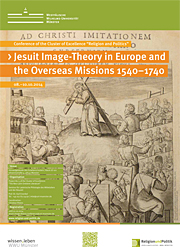Jesuit image-theory
International conference on Jesuit interest in images in the early modern period

The Jesuit investment in images, whether verbal or visual, virtual or actual, pictorial or poetic, rhetorical or exegetical, was strong and sustained, and may perhaps even be identified as one of the order’s defining characteristics. Jesuit Christology often invokes the imago and its species – figura, pictura, repraesentatio, similitudo, simulacrum, speculum – as visual instruments best suited to expounding, within the limits of human capacity, the supreme mystery of the Incarnation. Construed as an act of divine image-making itself, the Incarnation licenses the production of further sacred images ad imitationem Christi. Jesuit rhetorics likewise embrace the resources of visual artifice, comparing the orator to a painter and inviting him to exploit the full range of rhetorical figures and ornaments in virtually pictorial feats of demonstrative oratory.
Although the Jesuit interest in images has been richly documented, the question of Jesuit image theory has yet to be approached from a multi-disciplinary perspective that examines how the image was defined, conceived, produced, and interpreted within the various fields of learning by the Society. The term image need not refer to a pictorial image. One might ask how and why the practitioner of spiritual exercises was expected to move between different registers of image, making the transition from a stilled mental image, often comprised by the lineaments of place, to a moving image composed of sensate and animate protagonists, such as Mary, Jesus, and the votary himself. How did such transitions assist the exercitant to track his ascent from sensory perception to mental discernment, from corporeal to spiritual sight? Upon what psychology of soul are such operations of the image-making faculty premised? (exc/han)
Conference “Jesuit Image-Theory in Europe and the Overseas Missions 1540–1740”, 8-10 October 2014
Lecture building of the Cluster of Excellence
Room JO 101
Johannisstr. 4
D-48143 Münster
ProgrammE
Wednesday, 8 October |
||
| 14:00-14:15 | Welcome and Introduction | |
| 14:15-15:00 | The Early Jesuits and the Catholic Debate about Sacred Images, 1530s-1560s | Wietse de Boer, Oxford, Ohio |
| 15:00-15:45 | Rhetoric, Enargeia and the Softening of Stone: Architectural Decoration and Hendrik van Balen’s marble paintings for the Antwerp Jesuit Church | Anna Knaap, Boston |
| 16:15-17:00 | The Image Theories of Early Modern Jesuits as Disciples of Thomas | Judi Loach, Cardiff, Wales |
| 17:00-17:45 | The Jesuit Theory of Accomodation | Jeffrey Muller, Providence, Rhode Island |
Thursday, 9 October |
||
| 09:00-09:45 | Le pacte précaire de l’image et de l’écrit dans le livre illustré d’époque moderne: le cas de la ‘Peinture spirituelle’ (1611) de Louis Richeome | Pierre-Antoine Fabre, Paris |
| 09:45-10:30 | Science and politics in some Jesuits’ frontispieces | Jacques Riche/ Bernard Deprez, Leuven |
| 10:50-11:35 | Ascension in the Cylinder: Theory and Practice of an Image Machine of Athanasius Kircher S.J. | Andreas Thielemann, Rome |
| 11:35-12:20 | The ‘De statura, plastice et statuaria’ of Jules César Boulanger, S.J. (1558–1628): Formation of the Jesuit Orator or of the ‘Curieux’? | Colette Nativel, Paris |
| 14:15-15:00 | Sandaeus and the imago figurata. The Jesuit Image Theory at the Crossroads of Speculative, Mystical and Symbolic Theologies | Ralph Dekoninck, Louvain-la-Neuve |
| 15:00-15:45 | Mystical Figures and Emblematic Practice in Maximilian van der Sandt’s Work | Agnes Guiderdoni, Louvain-la-Neuv |
| 16:15-17:00 | Abraham Janssen van Nuyssen (Liège? 1571/75 - Antwerp 1632): Jesuits in the Family and the Main Altarpiece of the Jesuit Church in Mons | Joost Vander Auwera, Brussels |
| 17:00-17:45 | Phoenix, Hen and Falcon: Robert Southwell and Henry Hawkins’ influence on Helena Wintour’s sacred embroidery for the Society of Jesus, 1650-1660 | Jan Graffius, Stonyhurst |
Friday, 10 October |
||
| 09:00-09:45 | ‘to make yourself present’: Space and Self in the Society of Jesus | Steffen Zierholz, Bern |
| 09:45-10:30 | Self-cultivation and Interior Retreat in Jesuit and Courtly Culture: The Hermitages of Wilhelm V, Duke of Bavaria | Christine Goettler, Bern |
| 10:50-11:35 | ‘Libellus piarum precum’ (1575): Iterations of the Five Holy Wounds in an Early Jesuit Prayerbook | Walter Melion, Atlanta |
| 11:35-12:20 | Spiritual Perception in Peter Canisius’ Meditations on Advent | Hilmar Pabel, Burnaby |
| 14:15-15:00 | Claude-François Ménestrier: The Founder of ‘Early Modern Grounded Theory’ | David Graham, Montreal |
| 15:00-15:45 | ‘Simulacra avorum’: Two Jesuit Imitations of Vergil, Aeneid, VI, 756-887 | Aline Smeesters, Louvain-la-Neuve |
| 16:15-17:00 | A Variety of Spiritual Pleasures: Anthonis Sallaert’s ‘Glorification of the Name of Jesus’ | James Clifton, Houston |
| 17:00-17:45 | Writing on the Body and Looking through the Wounds: the mnemonic metaphor of Stigmata | Andrea Torre, Pisa |
| 17:45-18:00 | Final Discussion/ Concluding Remarks | |

